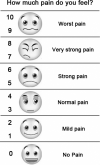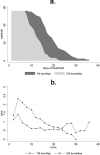Influence of activation protocol on perceived pain during rapid maxillary expansion
- PMID: 25757063
- PMCID: PMC8612036
- DOI: 10.2319/112114-833.1
Influence of activation protocol on perceived pain during rapid maxillary expansion
Abstract
Objective: To investigate the influence of two different activation protocols on the timing and intensity of pain during rapid maxillary expansion (RME).
Materials and methods: A total of 112 prepubertal patients (54 males and 58 females, mean age 11.00 ± 1.80 years) with constricted maxillary arches underwent RME with two different activation protocols (group 1: one activation/day; group 2: two activations/day). Patients were provided with a numeric rating scale (NRS) and the Faces Pain Scale (FPS) to correctly assess their daily pain.
Results: Subjects treated with RME at two activations/day reported statistically significantly greater amounts of pain than subjects treated with RME at one activation/day. Differences related to gender and skeletal maturity were found.
Conclusion: The choice of activation protocol influences the perceived pain during RME, and less daily expansion is correlated to less pain. Pain reported during RME could be influenced by skeletal maturity and gender of the subjects under treatment.
Keywords: Orthodontic appliance; Pain; Rapid maxillary expansion; Rapid palatal expansion.
Figures



References
-
- Thilander B, Wahlund S, Lennartsson B. The effect of early interceptive treatment in children with posterior cross-bite. Eur J Orthod. 1984;6:25–34. - PubMed
-
- Kurol J, Berglund L. Longitudinal study and cost-benefit analysis of the effect of early treatment of posterior cross-bites in the primary dentition. Eur J Orthod. 1992;14:173–179. - PubMed
-
- Korbmacher H, Huck L, Merkle T, Kahl-Nieke B. Clinical profile of rapid maxillary expansion—outcome of a national inquiry. J Orofac Orthop. 2005;66:455–468. - PubMed
-
- Needleman HL, Hoang CD, Allred E, Hertzberg J, Berde C. Reports of pain by children undergoing rapid palatal expansion. Pediatr Dent. 2000;22:221–226. - PubMed
Publication types
MeSH terms
LinkOut - more resources
Full Text Sources
Medical
Miscellaneous

